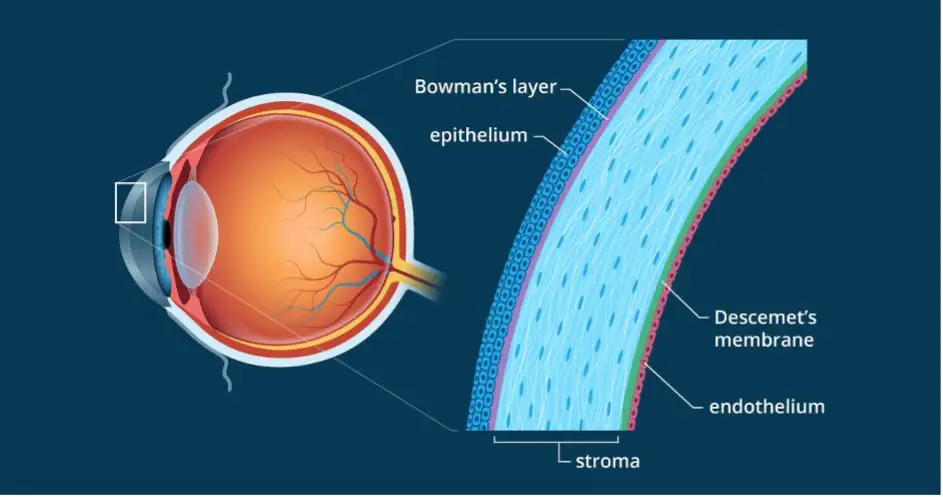Most focusing occurs at the cornea and a lesser amount in the natural lens of the eye. The cornea is about 12mm in diameter (it is actually more elliptic than circular) and is just over half a millimetre thick. Although transparent, the cornea is made up of a number of layers of fibrous tissue, creating a surprisingly strong structure able to protect the eye from injury.
 Layers of the cornea
Layers of the cornea
- The epithelium is the surface layer of cells. This is the layer that gets scratched, for example, if you get sand in your eye. It is able to regenerate quickly and repair itself.
- Bowman’s layer is a tough, fibrous layer that supports the epithelium. This layer resists deep damage to the cornea and is quite transparent.
- The stroma makes up the bulk of the cornea and comprises carefully aligned bundles of collagen fibres to be strong but transparent. During laser vision correction surgery, it is the stromal layers that are reshaped.
- Descemet’s membrane forms a layer for the innermost cells to align on.
- The endothelium is a delicate layer of cells that are vital for the health of the cornea. These cells cannot regenerate and if damaged can result in corneal failure.
Function of the cornea
The cornea, with its overlying tears, is an important optical element, giving most of the eyes focusing power. If the cornea is too steeply curved or too flat the eye will be myopic or hyperopic, and an asymmetric curve will cause astigmatism. Laser surgery corrects for myopia, hyperopia and astigmatism by modifying the curvature of the cornea. Only a very small change in curvature is needed to give a significant change in the eye’s focusing.
As a layer of the eye, the cornea needs to be transparent and also strong enough to maintain the shape of the eye. In some diseases (keratoconus) the cornea is made of abnormal fibrous tissue that lacks adequate strength to resist the pressure in the eye and the cornea begins to bulge and become conical in shape. This irregular curvature causes poor vision and corneal transplant surgery may be required.
Problems in the Cornea
The most common corneal problems are abrasions when external objects come into contact with the eye. These will normally heal with no scarring, although antibiotic drops are often used as a precaution. Infections of the cornea are commonly caused by contact lenses. These can be sight-threatening. Other corneal infections may occur in compromised situations and require urgent attention with identification of the infection and appropriate antibiotics.
Dry eye, while not really a condition of the cornea, will affect corneal function. The tear film is a complex structure that both protects the cornea and optimises the optical qualities of the corneal surface. Dry eye is better called ‘Ocular Surface Disease’ as it is not really dryness of the eye but an abnormality of the tear layer. This is a common condition affecting up to 30% of people.
Degenerative conditions of the cornea often have genetic patterns and sometimes result in the need for corneal transplant surgery. Corneal ectasia is a progressive bulging of the cornea resulting in poor vision that often can’t be improved with glasses. Ectasia (keratoconus) is treated with hard contact lenses, implantable contact lens, corneal strengthening with cross-linking and sometimes partial-thickness corneal transplants.
The cornea is an amazing structure that is both delicate and strong, precisely allowing light to be perfectly focused into the eye while protecting the eye as a self-healing barrier against injury.

